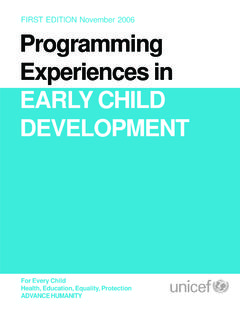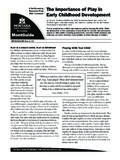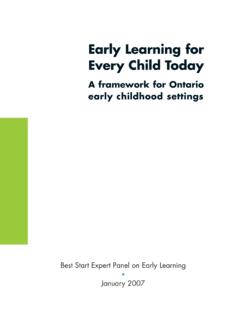Transcription of KNOWLEDGE NETWORK For EARLY CHILD …
1 KNOWLEDGE NETWORK For EARLY CHILD development Analytic and Strategic Review Paper: International Perspectives on EARLY CHILD development Prepared by Stefania Maggi Lori G. Irwin Arjumand Siddiqi Iraj Poureslami Emily Hertzman & Clyde Hertzman for the World Health Organization s Commission on the Social Determinants of Health December 2005 2 Table of Contents Executive Summary .. 3 The Social Determinants of EARLY CHILD development .. 6 Prenatal and Perinatal Periods (from conception to birth) ..6 Preschool and School Age (from birth to 8 years of age) ..8 Latent, Cumulative and Pathway effects for EARLY CHILD development .
2 9 Family Level Characteristics ..10 Neighbourhood-level Socio-Political Context ..15 The effects of the broader social policy context on ECD Policies that directly address ECD Policy: The intersection of the CSDH s KNOWLEDGE Networks with Overview of International ECD Programs and Lessons Learned .. 20 The Basis for Policy and Programs at the Regional, Country, and Global Level .. 25 References .. 30 Appendix A: Initiatives and ECD Programs .. 39 3 Executive Summary The present work builds on the affirmed desire of the Commission on Social Determinants of Health (CSDH) to be judged on both its scientific rigor and the policy implications that the Commission s work will generate.
3 It contributes to the general discussion on the social determinants of health by complementing the work of the Commission s other KNOWLEDGE Networks and by focusing on the fundamental conceptual issues relating to EARLY CHILD development and Education (hereafter ECD). The areas of focus for each of the Commission s KNOWLEDGE Networks Globalization, Social Exclusion, Health Systems, Gender, Urban Settings, Employment Conditions, Priority Public Health Conditions, and Measurement are critical to understanding the social determination of ECD, and as such will be integral to the work of the ECD NETWORK .
4 This work is the result of a review process which included a thorough literature review, input by the CSDH Commissioners, the CSDH WHO Secretariat, the September 2005 Ahmedabad, India 3rd meeting of the Commissioners, and site-visits to projects supported by the Self Employed Women s Association (SEWA) in Ahmedabad, India. There are important reasons for conducting this work. With advent of technologies that facilitate communication and connections among researchers and policy makers across the globe, we can now better support the previously recognized value of international collaborations in reciprocal learning and policy development .
5 The importance of international co-operation to protect the fundamental rights of children is also acknowledged in the UN Convention of the Rights of Children and encourages State Parties to undertake measures at the legislative and administrative levels to implement the rights of children recognised in the Convention within the framework of international co-operation (Article 4). While international co-operation is critically important, there are several challenges that limit the extent to which experiences, programs and research findings from one context related to EARLY childhood be applied to other contexts and cultural realities.
6 These challenges may range from cultural and language differences to differences in the extent to which some countries have the adequate resources to ensure that children s rights are protected and appropriate policies implemented. Thus, EARLY childhood development issues require a discussion at the global level in order to effectively apply KNOWLEDGE -based principles and implementation strategies across cultures and contexts internationally to promote healthy CHILD development . The critical importance of the first years of life is well acknowledged.
7 Three broad domains of EARLY CHILD development contribute to health, and have a role to play in health equity, across the life course: physical, social/emotional, and language/cognitive. EARLY CHILD development is influenced by EARLY life factors and experiences that are underlying social determinants of health. At the most intimate level the within family environmental attributes of stimulation, support, and nurturance influence all three key domains of ECD. There are a wealth of studies involving first world, immigrant, and developing country populations showing that nurturing qualities of family environments influence development and can be enhanced through intervention programs involving improved parenting skills, 4nutritional supplementation, and quality childcare arrangements.
8 Although long-term follow-up has occurred on only a subset of these studies, the results have been very promising. At the next level of social aggregation, neighbourhoods/communities influence ECD. The key aspects here are safety, cohesion, and the avoidance of ghettoization of poor and marginalized families. The Bernard van Leer and Aga Khan Foundations have both demonstrated that community development approaches to improving CHILD development are feasible and effective in developing country contexts. The challenges here are greater in urban environments than they are in village contexts because urban environments tend to create spatial separation among people from different walks of life and, thus, large differences in the qualities of the neighbourhood environments for children.
9 Nonetheless, taking ECD into account is important when considering the urban aspects of social determinants of health and their relationship to sustainable cities . In the urban context, the concept of spatial organization in the form of neighbourhoods is especially salient. Frequently, the literature finds, inequalities for a variety of outcomes within urban areas are apparent at the neighbourhood-level, in strong part due to inequalities in neighbourhood conditions. The effects of neighbourhood conditions on ECD are a particularly important lens through which neighbourhood organization should be assessed.
10 The development of sustainable cities should explicitly incorporate those neighbourhood conditions which are conducive to providing all children with the fundamental resources for healthy development . At the broadest level of social aggregation, socio-political and program delivery factors make a difference for ECD. Socio-political factors in this context refer to the national wealth and the economic trajectory of a given society; income distribution; patterns of employment and migration; and longstanding attitudes to mothers and children, all of which directly or indirectly influence the conditions under children grow up, live, and learn.


















